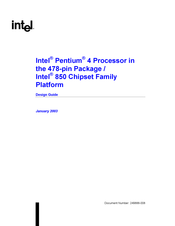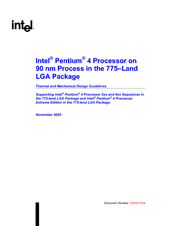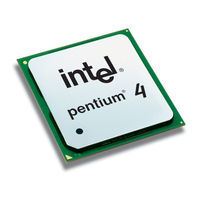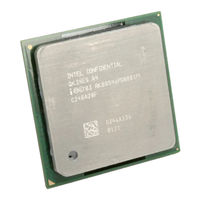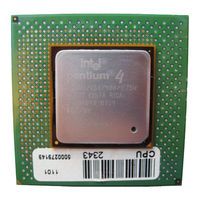Intel Pentium 4 Manuals
Manuals and User Guides for Intel Pentium 4. We have 11 Intel Pentium 4 manuals available for free PDF download: Design Manual, User Manual, Datasheet, Specification, Installation Notes, Product Overview
Intel Pentium 4 Design Manual (371 pages)
in the 478-pin Package / Intel
850 Chipset Family Platform
Brand: Intel
|
Category: Computer Hardware
|
Size: 12.78 MB
Table of Contents
Advertisement
Intel Pentium 4 User Manual (105 pages)
User Guide
Brand: Intel
|
Category: Computer Hardware
|
Size: 5.42 MB
Table of Contents
Intel Pentium 4 Datasheet (81 pages)
Pentium 4 Processor on 90 nm Process
Brand: Intel
|
Category: Computer Hardware
|
Size: 1.89 MB
Table of Contents
Advertisement
Intel Pentium 4 Specification (75 pages)
Processor on 90 nm Process
Brand: Intel
|
Category: Computer Hardware
|
Size: 0.65 MB
Table of Contents
Intel Pentium 4 Specification (74 pages)
Specification Update
Brand: Intel
|
Category: Computer Hardware
|
Size: 0.49 MB
Table of Contents
INTEL Pentium 4 Design Manual (15 pages)
Processor in 478-pin package 845 chipset platform for SDR
Brand: INTEL
|
Category: Computer Hardware
|
Size: 1.15 MB
Table of Contents
Intel Pentium 4 Design Manual (9 pages)
Brand: Intel
|
Category: Computer Hardware
|
Size: 0.12 MB
Table of Contents
Intel Pentium 4 Installation Notes (11 pages)
Brand: Intel
|
Category: Computer Hardware
|
Size: 1.79 MB
Intel Pentium 4 Installation Notes (2 pages)
Brand: Intel
|
Category: Computer Hardware
|
Size: 0.27 MB
Intel Pentium 4 Product Overview (2 pages)
Processors with Hyper-Threading Technology for Embedded Computing
Brand: Intel
|
Category: Computer Hardware
|
Size: 0.15 MB
Advertisement
